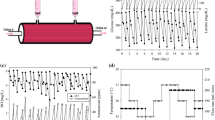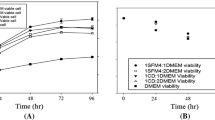Summary
Two intracapillary (IC) media feed protocols termed “media rich” and “media lean” were examined in an effort to understand the effect of this variable on hollow fiber cell cultures. The “media rich” protocol emphasized a high volume IC media per day (5 liters) containing no serum and a normal amount of extracapillary (EC) media serum (10% v/v). Alternatively, the “media lean” protocol used up to 1.0 liter of IC media per day containing 5% v/v serum and increased EC media serum (20% v/v). Both protocols produced substantial amounts of antibody in 25 days using HFN7.1 hybridoma cells (ATCC CRL 1606), however the “media rich” protocol produced twice as much antibody as the “media lean” protocol. The metabolism of the cells was dramatically different as measured by glucose uptake rate (GUR) with “media lean” cells having a six-fold lower GUR. Our results indicate that the “media rich” protocol is useful for producing larger amounts of antibody in a short time frame. The “media lean” protocol may be considered when the production costs of antibody, particularly media and serum, is the overriding concern.
Similar content being viewed by others
References
Knazek, R. A., Gullino, P. M., Kohler, P. O. and Dedrick, R. L. 1972. Science 178: 65–67.
Evans, T. L. and Miller, R. A. 1988. Biotechniques 6: 762–767.
Heifetz, A. H., Brantz, J. A., Wolfe, R. A., Barry, R. M., Miller, D. A., and Solomon, B. A. 1989. Biotechniques 7: 192–199.
Rosenberg, J., Sorenson, J., Veeramallu, U. and Gebhard, T. 1990. Amer. Biotech. Lab. 8: 34–39.
Lin, A. Y., Devaux, B., Green, A., Sagerstrom, C., Elliott, J. F., and Davis, M. M. 1990. Science 249: 677–679.
McKillip, E.R., Giles, A. S., Levner, M. H., Hung, P. P., and Hjorth, R.N. 1991. Bio/Technology 9:805–810.
Lowrey, D. M., Torre, M., Thorn, R., and Guar, P. 1990. FASEB Journal 4: A2198.
Lowrey, D. M., Meslovich, K., Murphy, S., Veeramallu, U., Nguyen, A. and Goffe, R. A. 1993. Small scale in vitro antibody production using a disposable hollow fiber device. The 12th Meeting of the European Society for Animal Cell Technology (ESACT), Wurzburg, Germany, May, 1993.
Andersen, B. G. and Gruenberg, M. L. 1987. Optimization techniques for the production of monoclonal antibodies utilizing hollow-fiber technology. In: Commercial Production of Monoclonal Antibodies, a Guide for Scale-up, S. S. Seaver, (ed.), Marcel Dekker, Inc. NY.
Author information
Authors and Affiliations
Rights and permissions
About this article
Cite this article
Lowrey, D., Murphy, S. & Goffe, R.A. The effect of intracapillary media feed protocols on hollow fiber cell culture. Biotechnol Lett 15, 1025–1030 (1993). https://doi.org/10.1007/BF00129931
Issue Date:
DOI: https://doi.org/10.1007/BF00129931




